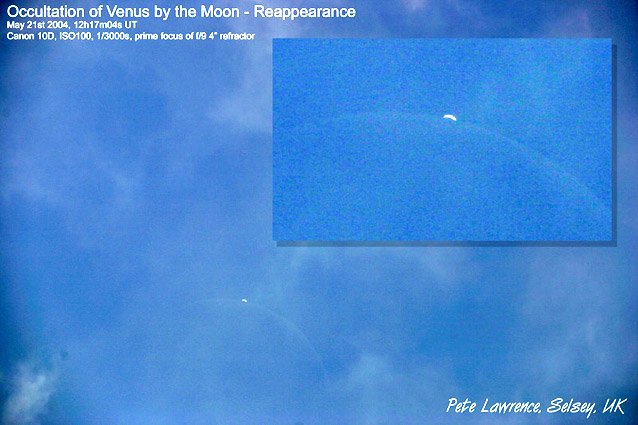An occultation occurs when one body moves in front of another. During it’s monthly cycle, the Moon may move in front of certain stars and planets. Although our mind’s eye view of the Moon is of a large object dominating the night sky, in reality the Moon only subtends a tiny apparent angle (~30 arcmins in diameter). As such, the number of occasions when the Moon passes in front of a reasonably bright star are not as numerous as you might think, but the International Occultation Timing Associations predicts such events. On May 21st 2004 the Moon passed in front of the brightest planet of them all – Venus, allowing daytime observers to see two crescents of similar phase in the same area of sky at the same time (Venus phase = 9%, Moon phase = 4%). At the time of the May 21st occultation, Venus was an easy telescopic object (magnitude –4, apparent diameter 50 arcseconds). Although there have been a few Venus occultations each of the last few years, their relative infrequency is compounded by the fact that visibility is often limited to specific areas of the globe. The last such event was on October 26th 2003 and it could only be observed from a Pacific Ocean swath stretching from Hawaii to southern South America. The next occultation of Venus by the Moon will be on November 10th 2004 and will be visible from Australia, New Zealand and South Asia.
Related Links:
Peter Lawrence Images
Anthony Ayiomatitis Venus Occultation Images
IOTA's Venus Occultation Predictions
|
Yanvar' Fevral' Mart Aprel' Mai Iyun' Iyul' Avgust Sentyabr' Oktyabr' Noyabr' Dekabr' |
|
Publikacii s klyuchevymi slovami:
Moon - Luna - Lunar Photo of the Day - LPOD
Publikacii so slovami: Moon - Luna - Lunar Photo of the Day - LPOD | |
Sm. takzhe:
Vse publikacii na tu zhe temu >> | |
